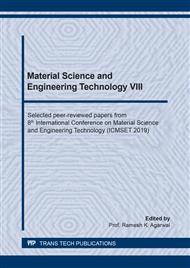p.283
p.293
p.299
p.305
p.311
p.317
p.323
p.329
p.335
Correlation of Unconfined Compressive Strength and California Bearing Ratio in Laterite Soil Stabilization Using Varied Zeolite Content Activated by Waterglass
Abstract:
In remote areas, most roads still use pavements that are very sensitive to climate change, especially those using clay pavements with high plasticity. In addition to the issue of cost, the difficulty of obtaining a proper source of material is another problem that has led to soaring prices for materials. In this regard, a study was conducted using local materials, namely zeolite as a stabilizing material added with waterglass as activating agent. The research began with samples of laterite soil and natural zeolite for XRD test (microstructure testing), and then testing for laterite soil’s index properties and engineering properties, namely Unconfined Compressive Strength and CBR value. The purpose of the test is to determine the correlation between the Unconfined Compressive Strength (UCS) and the soil bearing capacity (CBR) caused by adding zeolite as stabilizer material and waterglass as activator with increasing curing time. Laterite soils contain a brownish red iron oxide. The stabilizing material zeolite contains a crystalline mineral of alumina silicate SiO2. While waterglass composed of sodium meta silicate. Stabilization carried out by mixing 4%, 8%, 12%, 16%, and 20% of zeolite with addition of 2% waterglass, percentage was measured based on soil dry weight. Specimens were tested at curing time of 0, 7, 14, and 28 days. The test result shows increasing UCS and CBR values with increasing percentage of zeolite. At mix of 20% zeolite and 2% waterglass, the unconfined compressive strength reaches 23.54 kg/cm2 with CBR value 58% at 28 days of curing time.
Info:
Periodical:
Pages:
323-328
Citation:
Online since:
June 2020
Authors:
Keywords:
Price:
Сopyright:
© 2020 Trans Tech Publications Ltd. All Rights Reserved
Share:
Citation:


